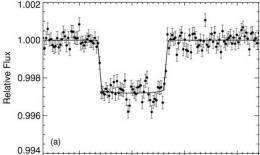The Hot Saturn Exoplanet

(PhysOrg.com) -- Of the roughly 350 known exoplanets (i.e., extrasolar planets), the one orbiting the star HD149026 is unique.
It has a mass comparable to that of Saturn but is much smaller in size, indicating that it is made up of a denser material such as ice or rocks. It is therefore quite unlike the large class of "hot Jupiters," giant exoplanets that are primarily composed of hydrogen and helium (and that are hot because they orbit close to their parent stars).
The comparatively unusual composition of this exoplanet may reflect the chemistry of the original stellar nebula, or perhaps something in the way it formed, or a combination of factors. Whatever the reasons, astronomers suspect that the atmosphere of this planet could also be comparatively unusual. As scientists explore the incredible, new field of exoplanet astronomy, these and other basic questions help to illuminate how our own earth was formed and how it is influenced by the sun.
A team of seven astronomers led by CfA scientists Heather Knutson and David Charbonneau used the IRAC camera on the Spitzer Space Telescope (the IRAC team is led by CfA astronomer Giovanni Fazio) to measure the daytime and nighttime temperatures of the Saturn-sized exoplanet around HD149026. It happens that this exoplanet is one of a few that transit its star, which is to say that its orbit directly crosses the line-of-sight of our view of the star.
As the planet passes behind the star, beginning its so-called secondary eclipse, the daylight side of the planet becomes visible for a short time. Using the IRAC camera, the scientists were able to measure the daytime brightness by watching the brightness of the planet change during this phase, with an amazing precision of about 0.04%. They calculate the daytime temperature to be about 1440 kelvin, a value significantly smaller than previous estimates; they also find the average nighttime temperature for the first time, and report that it is about 900 kelvin.
The temperature difference between the day and night side is largely a result of the exoplanet's atmosphere. The scientists argue that the atmosphere shows evidence for some combination of atmospheric circulation, water absorption, and reflectivity. Furthermore, they are able to estimate the energy budget of the planet, and find that, like other planets that reflect some of the incident starlight (often due to clouds), it appears to emit less flux than it receives from its parent star, although this conclusion is tentative pending observations at other wavelengths. The new paper is a dramatic illustration of the power of the new generation of astronomical instruments whose effectiveness comes not only from their being sensitive, but also from their ability to make extremely precise measurements.
Provided by Harvard-Smithsonian Center for Astrophysics (news : web)
















